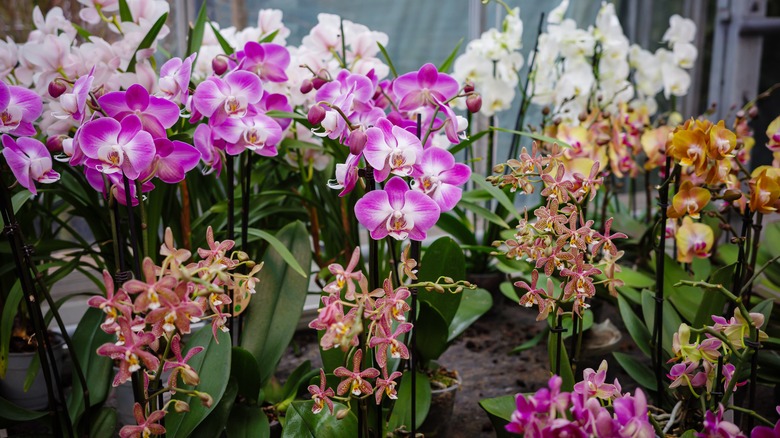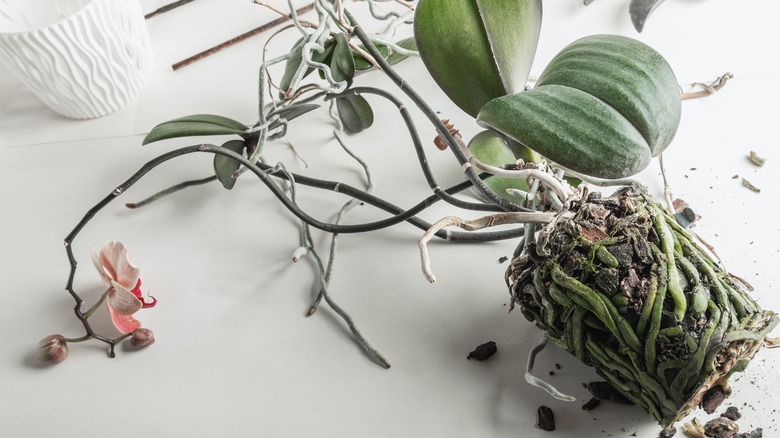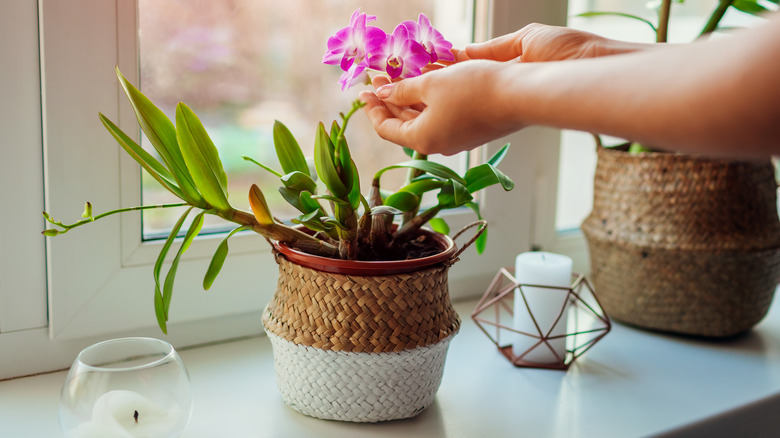Monopodial Vs Sympodial Orchids: Here's The Real Difference Between These Similar Flowers
The world of orchids is vast. In fact, they belong to the biggest family of flowering plants, which makes choosing the right type of orchid to grow and care for overwhelming. If you're new to this plant, know that they fall into one of two types: monopodial or sympodial. Knowing which category your orchid falls into clues you into what to expect as it grows and helps you create a customized care routine.
Monopodial orchids have one stem growing vertically from the middle, and a corresponding root system, while sympodial orchids have more than one root system and several nutrient-storing structures called pseudobulbs. Flowers on a monopodial orchid, like the vanda, bloom on spikes that sprout from the space between the stem and leaf. The plants get taller with each leaf that grows from the stem,though the growth is slow. (Expect one or two leaves per year). In sympodial orchids, like corsage orchids (Cattleya), you can check the place where the pseudobulb meets the plant's leaf base to see if a flower is developing. It's normal to notice the pseudobulbs (which are actually a type of stem) dry up over time.
Whether an orchid is monopodial or sympodial makes a difference. There are variations in the care tasks you'd undertake, such as repotting and watering. Monopodial types need to be watered more often. (Unlike sympodial orchids, they don't have water-retaining pseudobulbs). Because of their wonky growing habits, sympodial orchids also benefit from being held in place with twine or clips.
Growth type matters when repotting your orchids
A plant's growth pattern affects the steps you need to take when you're attempting to repot your orchid. Before trying to give any orchid a new home, make sure it's not currently blooming. The time to get your plant into a new pot is after the blooms have died and new buds are forming. With both types of orchids, trim off dead leaves, roots, and flower spikes first, then place the base of the plant at the same level it sat at in the previous container.
It's easier to transplant upright-growing monopodial types, which can be replanted right in the middle of a new pot. This is usually done every two years, and the plant's legginess after the lower leaves drop will be a clue that it's time for a change.
Sympodial orchids, on the other hands, grow in one direction, so it's best to inspect the way they're growing. Look for new bulbs on their horizontal stem and make sure there's enough growing room between them and the edge of the pot. Old pseudopods can be removed if their flowers have already bloomed, or left to fall off on their own time. This type of orchid is also typically repotted after two years. When the stem arches too far over one side of the pot or roots start growing to the side, though, it's definitely time to give your sympodial orchid a new home.
Bloom and pruning needs vary with each orchid type
Whether your plant is monopodial or sympodial also makes a difference in how you prune your orchid to keep it happy and healthy. Sympodial orchids have new stems growing out of the old horizontal stems each year. In monopodial orchids like moth orchids (Phalaenopsis), however, the new growth appears near the pot's surface as the single stem gets taller and more leaves emerge, and new flowers tend to branch out of old spikes.
When you prune a monopodial orchid, you can cut withering flower spikes to half an inch above the second node, or the swelling part you see on the stem. This orchid type has regular growth throughout the year and often blooms yearly, so in addition to consistent watering and fertilizing, snipping off the spent flower spikes can spur them to produce more flowers.
Sympodial orchids can also have dead flowers pruned off, but you can trim them all the way back to the base of the stem and leave the stem intact. When it comes to blooming needs, some types of sympodial orchids, such as Cattleya and dendrobium, need twice as much light as their monopodial relatives to flower. Instead of regular blooming, they have a growing season followed by a resting period, which is how they survive their native habitat. They need less water, and no fertilizer, when resting to keep their natural bloom cycle going.


